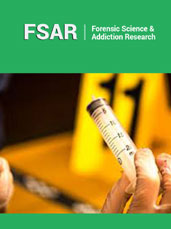- Submissions

Full Text
Forensic Science & Addiction Research
Uncharted Frontiers in Forensic Entomology: Under-Explored Research Areas and Emerging Opportunities
Walid Kaakeh*
Freelance Forensic Entomologist, Mersin, Turkey
*Corresponding author:Walid Kaakeh, Freelance Forensic Entomologist, Mersin, Turkey
Submission: May 06, 2025;Published: June 02, 2025

ISSN 2578-0042 Volume6 Issue 4
Abstract
Forensic entomology, traditionally focused on Post Mortem Interval (PMI) estimations, is now branching into new, interdisciplinary domains. This two-page review highlights emerging and under-explored areas in the field, such as microbial-insect interactions, Environmental DNA (eDNA), insect-associated microbiomes, entomotoxicology, climate change impacts, and the integration of Artificial Intelligence (AI). The review underscores the potential of these areas to reshape forensic practices, while addressing the challenges and prospects for future research.
Introduction
Forensic entomology is a well-established subfield of forensic science, primarily employed to estimate the Postmortem Interval (PMI) using insect succession and development data. Despite its proven utility, much of the research remains confined to classical methodologies involving Diptera and Coleoptera on cadavers. However, recent technological advances, growing ecological concerns, and cross-disciplinary integration have begun to open new frontiers in forensic entomology, inviting a deeper look at less conventional yet promising domains.
Emerging and under-explored areas
Insect microbiome and postmortem microbial succession: Recent studies indicate that the gut microbiota of necrophagous insects change predictably during decomposition, suggesting a new microbial clock for PMI estimation. The synergistic study of entomological and microbial succession could provide more accurate forensic timelines [1-3]. Yet, the complexity of host-microbe-environment interactions remains under-explored.
Entomotoxicology: The study of how toxins and drugs in decomposing tissues influence insect growth and behavior is still in its infancy. Entomotoxicology holds promise in determining the type and concentration of substances consumed prior to death, even when traditional biological samples are degraded [4]. Standardized methodologies and speciesspecific databases are needed to enhance its forensic utility.
Environmental DNA (eDNA) and metabarcoding: eDNA technologies enable the non-invasive collection and identification of insect species from environmental samples. Metabarcoding of insect remains can improve species identification in complex samples, particularly in urban or tropical environments where morphological identification is challenging [5].
Climate change and insect distribution: Shifting insect populations due to global warming can alter colonization patterns and developmental rates, directly affecting PMI estimation. This necessitates localized, updated forensic databases that reflect current climatic conditions [6]. Long-term research on climate-induced phenological changes in forensically important insects is urgently needed.
AI, machine learning and predictive modeling: AI can automate species identification from images and assist in PMI prediction models based on large entomological datasets. These technologies could reduce human error and increase efficiency but require standardized image datasets and cross-validation with real-world forensic cases.
Cultural and regional gaps in research: Many regions, particularly in Africa, the Middle East, and Southeast Asia, lack localized forensic entomology data. Given the ecological specificity of insect succession, region-based studies are crucial for globally applicable forensic models.
Challenges and future directions
While these emerging fields are promising, they face several
challenges:
A. Standardization of protocols for microbial and
toxicological analysis.
B. Validation of AI tools with casework data.
C. Cross-disciplinary collaboration between entomologists,
microbiologists and forensic investigators.
D. Funding and infrastructure in low-research regions.
Investing in these under-researched areas can lead to the development of more comprehensive, context-aware and accurate forensic entomological tools.
Conclusion
The future of forensic entomology lies in broadening its scope beyond classical PMI estimation. By embracing technological innovation and ecological complexity, the field is poised to offer new insights into forensic investigations. The under-explored domains of microbiomes, eDNA, entomotoxicology, and AI integration represent fertile grounds for research and application, promising a more robust and interdisciplinary forensic science landscape.
References
- Amendt J, Richards CS, Campobasso CP, Zehner R, Hall MJ (2011) Forensic entomology: Applications and limitations. Forensic Science, Medicine and Pathology 7(4): 379-392.
- Introna F, Campobasso CP, Goff ML (2001) Entomotoxicology. Forensic Science International 120(1-2): 42-47.
- Jusino MA, Banik MT, Palmer JM, Wray BD, Xiao L, et al. (2016) An improved method for utilizing high-throughput amplicon sequencing to determine the diets of insect herbivores. Molecular Ecology Resources 17(5): 968-980.
- Martinez D, Rios A, Velásquez R (2020) Machine learning applications in forensic entomology: Current trends and future prospects. Forensic Science International: Synergy 2: 1-8.
- Metcalf JL, Wegener PL, Gonzalez A, Lauber CL, Knights D, et al. (2016) Microbial community assembly and metabolic function during mammalian corpse decomposition. Science 351(6269): 158-162.
- Tomberlin JK, Mohr R, Benbow ME, Tarone AM, VanLaerhoven S (2012) A roadmap for bridging basic and applied research in forensic entomology. Annual Review of Entomology 57: 147-164.
© 2025 Walid Kaakeh. This is an open access article distributed under the terms of the Creative Commons Attribution License , which permits unrestricted use, distribution, and build upon your work non-commercially.
 a Creative Commons Attribution 4.0 International License. Based on a work at www.crimsonpublishers.com.
Best viewed in
a Creative Commons Attribution 4.0 International License. Based on a work at www.crimsonpublishers.com.
Best viewed in 







.jpg)






























 Editorial Board Registrations
Editorial Board Registrations Submit your Article
Submit your Article Refer a Friend
Refer a Friend Advertise With Us
Advertise With Us
.jpg)






.jpg)














.bmp)
.jpg)
.png)
.jpg)










.jpg)






.png)

.png)



.png)






